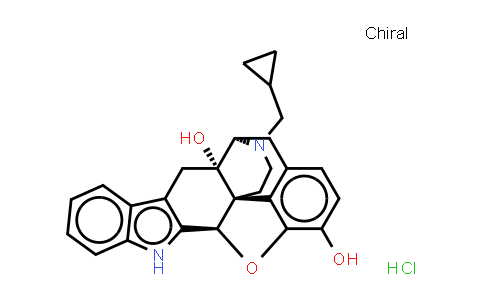
Naltrindole (hydrochloride) NLT 98%
Product Number : MC506823
CAS Number : 111469-81-9
Molecular Formula : C26H27ClN2O3 | Molecular Weight : 450.96
Quote Request| Purity | NLT 98% |
|---|---|
| Storage | at 20ºC 2 years |
| MolCore specializes in manufacturing high-purity CAS No.111469-81-9, Naltrindole (hydrochloride) with the molecular formula C26H27ClN2O3 and molecular weight 450.96 delivering critical API intermediates for global pharmaceutical and research industries, certified under ISO quality systems. | |
* The above information is for reference only.
| Chemical Name | Naltrindole (hydrochloride) |
|---|---|
| CAS Number | 111469-81-9 |
| MDL Number | MFCD00069313 |
| Molecular Formula | C26H27ClN2O3 |
| Molecular Weight | 450.96 |
Naltrindole hydrochloride is a highly potent and selective non-peptide δ opioid receptor antagonist with a Ki of 0.02 nM. IC50 & Target: Ki: 0.02 nM (δ opioid), 64 nM (μ opioid), 66 nM (κ opioid)[1] In Vitro: Opioid drugs exert a wide spectrum of physiological and behavioral effects. These effects are mediated via membrane-bound receptors, of which the best characterized are the kappa, delta, and mu receptors[1]. Naltrindole inhibits the proliferation of cultured human U266 MM cells in a time- and dose-dependent manner with an EC50 of 16 μM. Treatment of U266 cells with naltrindole significantly decreases the level of the active, phosphorylated form of the kinases, extracellular signal-regulated kinase and Akt, which may be related to its antiproliferative activity[2]. Naltrindole inhibits growth and induces apoptosis in the three characteristic SCLC cell lines, NCI-H69, NCI-H345, and NCI-H510. Naltrindole treatment reduces constitutive phosphorylation of Akt/PKB on serine 473 and threonine 308 in cells and also its downstream effectors glycogen synthase kinase-3β and the Forkhead transcription factors AFX and FKHR[3]. In Vivo: Naltrindole significantly decreases tumor cell volumes in human MM cell xenografts in severe combined immunodeficient mice[2]. In mice, naltrindole at 20 mg/kg s.c. antagonizes the δ-selective agonist effect of [D- Ser, Leu, Thr]enkephalin (DSLET) without blocking the antinociceptive effect of morphine or U50488H. Naltrindole is the only highly selective δ antagonist that is active upon peripheral administration[4]. Acute naltrindole induces significant decreases in external and total ambulation (horizontal activity) and rearing behaviour (vertical activity), as well as a significant increase in grooming frequency. In animals chronically treated with naltrindole there is an increase in total ambulation one day after the discontinuation of the treatment[5].
© Copyright 2015-2025 Hangzhou MolCore BioPharmatech Co.,Ltd. All rights reserved.
